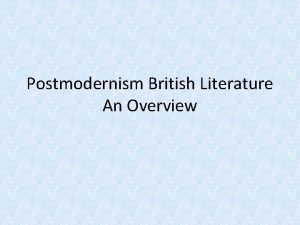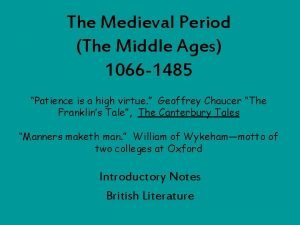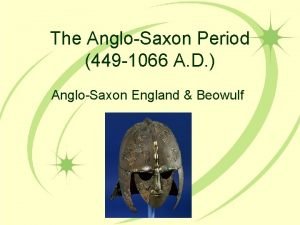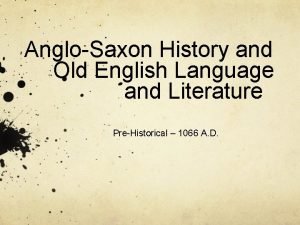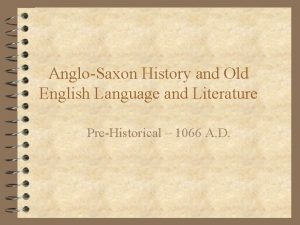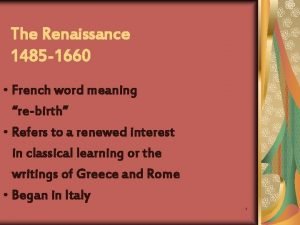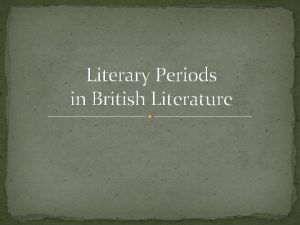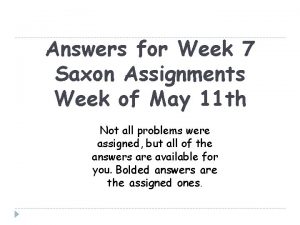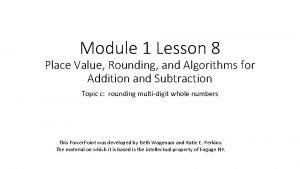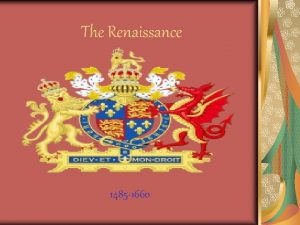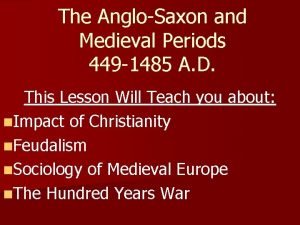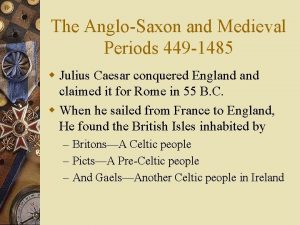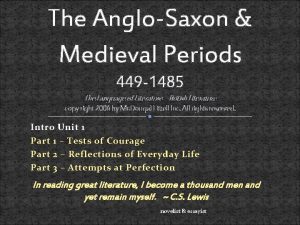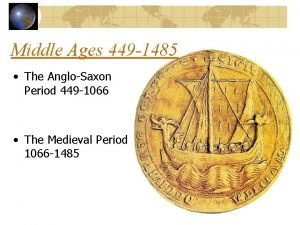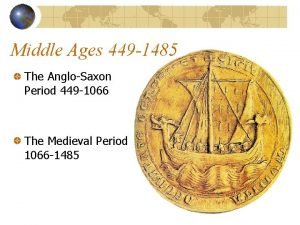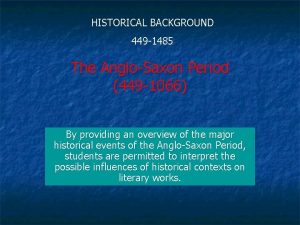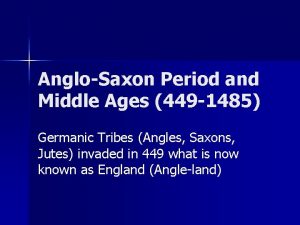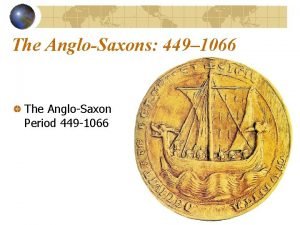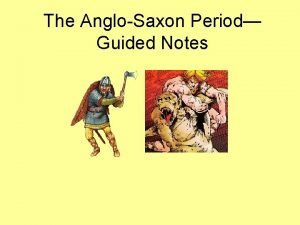The AngloSaxon and Medieval Periods 449 1485 English















- Slides: 15

The Anglo-Saxon and Medieval Periods 449 - 1485 English IV Ms. Reyes *notes from The Language of Literature, pgs. 18 - 29

Introduction n n In 55 B. C. , Julius Caesar sailed from what is now France to Britain to assert Rome’s authority over it. A century after his visit, the Roman armies conquered the Britons and Britain became part of the great Roman Empire. The Romans introduced cities, written scholarship, and eventually Christianity. Early in the 5 th century, Roman armies abandoned Britain to defend the city of Rome. It was not long before Britain too was invaded.

The Anglo-Saxon Period (449 – 1066) n n n Anglos, Saxons, and other Germanic people left their northern European homelands and began settling on Britain’s eastern and southern shores. The area of Germanic settlement became known as Angle-land, or England, and its people came to be called English. Early society centered on ancestral tribes, each ruled by a chieftain surrounded by a group of warriors who served him in return for rewards and protection.

The Growth of Christianity n n Early invaders brought their pagan religion marked by a strong belief in wyrd, or fate. People admired heroic warriors whose wyrd it was to prevail in battle. In 597, a Roman missionary named Augustine arrived in Kent, where he established a monastery at Canterbury. Christianity spread so rapidly that by 690 all of Britain was at least nominally Christian.

The Danish Invasions n n n In the 790’s, the Danes (a. k. a. the Vikings) began to devastate the flourishing culture and in time gained control of much of northern and eastern England. In the south, the Danes were forced to agree to a truce and accept Christianity after being defeated by Alfred the Great. The tug-of-war continued, however, even after Alfred’s death. The last successful invasion of Britain (The Norman Conquest) was led by William the Conqueror (Duke of Normandy) in 1066 and William was crowned King of England.

Literary History n n The spread of Christianity also brought a spread of literacy in Britain. The Roman alphabet was introduced in place of the runic alphabet. Poems were more likely to be written down, even though they were primarily an oral art; most poems had an anonymous author. The most famous survivor of poetry is the epic Beowulf, about a legendary hero of the northern European past.

The Medieval Period (1066 – 1485) n n n Before invading England, the Normans had adopted French ways. William now introduced these practices to England. William introduced the idea of a social ladder and feudalism, a political and economic system in which the hierarchy of power was based on the premise that the king owned all the land in the kingdom. Strong castles, cathedrals and abbeys were constructed.

The Medieval Period cont. n n n When Henry II, a descendant of William, took the throne, he instituted royal courts, established a system of juries, and initiated the formation of English common law. As a former French queen, Henry’s wife, Eleanor of Aquitaine, brought the idea of chivalry: a code of honor intended to govern knightly behavior. The code of honor encouraged knights to protect their ladies and to go on holy quests.

The Decline of Feudalism n n n In medieval towns, merchants and craftspeople formed organizations called guilds to control the flow and price of goods. The growth of towns meant the decline of feudalism, since wealth was no longer based exclusively on land ownership. As towns were becoming centers of commerce, universities were becoming England’s chief centers of learning.

The Hundred Years’ War n n n A long struggle between England France that continued on and off for more than a century Also significant to the Hundred Years’ War: n Black Death – plague which killed a third of England’s population n The Peasants’ Revolt of 1381 n Richard II’s forced abdication in 1399 n Henry IV takes the throne n Wars of the Roses The end of the Wars of the Roses marked the end of Middle Ages in England.

The Epic A long, narrative poem that celebrates a hero’s deeds n Came into existence as spoken words and were retold by poet after poet from one generation to the next n Many epics based on historical fact n Epics provided both entertainment and education for audience

Characteristics of epics n n n The hero is of noble birth or high position, and often of great historical or legendary importance. The hero’s character traits reflect important ideals of his society. The hero performs courageous deeds that reflect the values of the era. The actions of the hero often determine the fate of a nation of people. The setting is vast in scope, often involving more than one nation.

Characteristics of epics n n n The poet uses formal diction and a serious tone. Major characters often deliver long, formal speeches. The plot is complicated by supernatural beings or events and may involve a long and dangerous journey through foreign lands. The poem reflects values such as courage and honor. The poem treats universal themes, such as good and evil or life and death.

Features of epic poetry n n Stock epithets – adjectives that point out special traits of particular persons or things (e. g. , “swift-footed” used to describe Achilles) Kennings – poetic synonyms that may be a descriptive phrase or compound word that substitutes for a noun (e. g. , in Beowulf, “the Almighty’s enemy” and “sin-stained demon” are used in place of Grendel’s name)

Features of epic poetry n n Alliteration – repetition of consonant sounds at the beginning of words, used to heighten moods, emphasize words or images, or create musical effects Caesura – Old English poetry has a strong rhythm, with each line divided in two parts by a pause, called a caesura
 Literary movements in british literature
Literary movements in british literature Middle english period 1066 to 1485
Middle english period 1066 to 1485 Anglosaxon period
Anglosaxon period Anglosaxon history
Anglosaxon history Anglosaxon period
Anglosaxon period It is a french word which means rebirth
It is a french word which means rebirth The english renaissance 1485 to 1660
The english renaissance 1485 to 1660 The old english period
The old english period Cpsc 449
Cpsc 449 Davies v waldron (1989) vr 449
Davies v waldron (1989) vr 449 Cs 449
Cs 449 Gordon lu
Gordon lu The anglo-saxon period 449 to 1066 answers
The anglo-saxon period 449 to 1066 answers Lesson 8 use place value to round numbers answer key
Lesson 8 use place value to round numbers answer key Grčko-persijski ratovi
Grčko-persijski ratovi The renaissance 1485 to 1660 answers
The renaissance 1485 to 1660 answers
